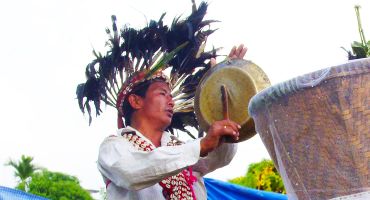There is always a prerequisite to calling a community, a tribe. It’s the clan structure, a custom which a tribe must ascertain to tracing descent and to follow a lineage. The Tamang community is usually classified as Baara Tamangs (Twelve Tribes) and the Atharah Jaat (Eighteen Sub-Tribes). This was the Tamang rhetoric when asked about the sub-tribes of the Tamang tribe. It should be noted that the word “Jaat” is colloquial and comes from the Nepali word which literally means Caste. The Tamang word for “Clan” is Rui.
Every tribe had its own custom for tracing descent. There may be tribes who trace it through their male members while some do it through matrilineal clan structure. The Tamang clan system serves as a foundation for social control and religious protocol for honor and respect. This system is a patrilineal affiliation where clan membership is passed by the father to the children.
The Tamang people who do not fall into the Hindu system of caste should not have been using the term “Jaat” to denote a clan or a sub-tribe, but over the many centuries of being in close proximity to the Hindu cultures, Tamangs freely use the terms Bara Tamang and Atharah Jaat to describe their clan structure. It should be noted here that the 12 Tamang Tribes usually consider themselves pure and above the rest. Eden Vansittart in his book, The Gurkhas (published in 1906) names the twelve Tamang sub-tribes as:
1. Baju
2. Bal
3. Dumjan
4. Ghishing
5. Giaba
6. Goley
7. Mikchan
8. Moktan
9. Pakrin
10. Syangdhen
11. Theeng
12. Yonjan
According to NJ Allen, in his study titled, Fourfold classifications of society in the Himalayas, he says that the Tamangs originated from the four families living in Wuijhang, Tibet and they were Bal, Yonjon, Moktan, and Ghising. This notion, according to Allen, comes from the origin story of the Tamangs themselves. The Tamangs, like the Gurungs, are usually described as consisting of a superior and an inferior stratum having numerical names.
Traditionally Tamangs have been known to associate different clans with specific areas, settlements, and villages as their Bapsa, (the land of belonging). The different Rui or clans, each has their own association with the Bapsa distributed across the region and which have been their original settlement. The various kinds of connections, associations, and relationships between different clans connect these lands and titles and layout common and shared territory. The larger territory is further joined by linkages between the territorial divinities which protect the Bapsa. Many names of these sub-tribes or clans within the Tamang homogenous tribe seem to have come from the Bapsa.
It can be determined that in the ancient Tamang Tribal set up every facet was built around a certain amount of respect to clan roles. These would set precedents and these roles defined the conduct of individuals. The Tamang tribe in totality was an endogamous unit while the sub-tribes among themselves remained exogamous. Many scholars believe that those who married away from the tribe would often be considered an outcast, thereby creating variants of the 12 main sub-tribes. This gave rise to the mixed Atharah Jaat Tamangs. These “mixed-breed” Tamangs, however, were provided the same amount of social standing in comparison to the original 12.
While the original term deems the numeric value to be 18 Tamangs, the numbers are far more than that.
| 1. Bal | 2. Bomzon | 3. Blone | 4. Bamten |
| 5. Blendene | 6. Bajyu | 7. Chhyumi | 8. Choten |
| 9. Chhekpal | 10. Chauthen | 11. Zimba | 12. Moktan |
| 13. Theeng | 14. Gyabak | 15. Pakhrin | 16. Singden |
| 17. Titung | 18. Thokar | 19. Khyungba | 20. Lungba |
| 21. Glan | 22. Waiba | 23. Prabhuba | 24. Mokchan |
| 25. Lo | 26. Manangthen | 27. Ghale | 28. Syangbo |
| 29. Yonzon | 30. Jyumi | 31. Ghongba | 32. Tongsang |
| 33. Taisang | 34. Jongan | 35. Samten | 36. Mulung |
| 37. Negi | 38. Mamba | 39. Kamden | 40. Marpa |
| 41. Moden | 42. Sumba | 43. Rimten | 44. Jogna |
| 45. Sarpakhor | 46. Sugtal | 47. Hen | 48. Tupa |
| 49. Kalden | 50. Senten | 51. Myapa | 52. Thongten |
| 53. Lockten | 54. Lhaminkhor | 55. Kagate | 56. Damrang |
| 57. Domten | 58. Tunpa | 59. Tungden | 60. Gropchan |
| 61. Gondan | 62. Nasur | 63. Malachoki | 64. Mahindong |
| 65. Manden | 66. Fyuwa | 67. Syangden | 68. Balam |
| 69. Toiba | 70. Jaba | 71. Syamjan | 72. Gemsing |
| 73. Lopchan | 74. Golay | 75. Mitak | 76. Gangtang |
| 77. Ngarden | 78. Brosinger | 79. Lamaganju | 80. Plengden |
| 81. Gomchyo | 82. Shahangri | 83. Chimkan | 84. Gotthar |
| 85. Dong | 86. Dartang | 87. Dumjan | 88. Gyamden |
| 89. Ghising | 90. Rumba | 91. Hangjo | 92. Nikten |





Thanks you sir for explaining details in such a ellaborate way
Great works, need to read more about Tamang cultures, pujas they perform
Great work, Share more if you have any. Tamang cultures, prayers
I have heard of Chuzangqua mainly finds in rasuwa region. Anyone there, who knows about it. Which group it falls upon?